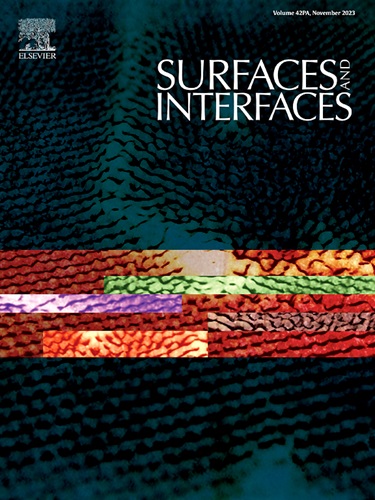FeAlNiCuCo高熵合金表面甲基红的降解
IF 5.7
2区 材料科学
Q2 CHEMISTRY, PHYSICAL
引用次数: 0
摘要
高熵合金(HEAs)是一种具有良好性能的新兴材料,但其在环境修复中的应用仍然有限。在本研究中,通过机械合金化合成了具有两种化学成分(Fe₅₁Al₂₃Ni₁₁Cu₁₀Co₅和Fe₃₄Al₂₄Ni₁₁Cu₂₀Co₁₁)的纳米结构HEA粉末,并对甲基红(一种持久性偶氮染料)的降解进行了评估。经x射线衍射证实,高能铣削40 h后,两种HEAs均形成体心立方(BCC)结构的固溶体,晶格参数为2.890 Å。FESEM和EDS化学图谱验证了合金的均匀性。磁性表征结果表明,HEA1的饱和磁化强度为115 emu/g, HEA2的饱和磁化强度为68.70 emu/g。brunauer - emmet - teller分析表明,合金表面几乎没有孔隙,这表明降解发生在合金表面,HEAs在合金表面起着多相催化剂的作用。在60°C的酸性条件下(pH 1.00), HEA1和HEA2分别在4和5 min内达到99%的甲基红降解。HPLC-MS和HR-XPS分析确定了邻氨基苯甲酸是降解产物,并揭示了HEA表面上参与反应的官能团的存在。这些发现突出了HEAs作为高效、速效偶氮染料降解催化剂的潜力,并支持其在针对持久性污染物的环境技术中的更广泛应用。本文章由计算机程序翻译,如有差异,请以英文原文为准。
Degradation of methyl red at the surface of FeAlNiCuCo high-entropy alloys
High-entropy alloys (HEAs) are emerging materials with promising properties, yet their application in environmental remediation remains limited. In this study, nanostructured HEA powders with two chemical compositions (Fe₅₁Al₂₃Ni₁₁Cu₁₀Co₅ and Fe₃₄Al₂₄Ni₁₁Cu₂₀Co₁₁) were synthesized via mechanical alloying and evaluated for the degradation of methyl red, a persistent azo dye. After 40 h of high-energy milling, both HEAs formed solid solutions with a body-centered cubic (BCC) structure and a lattice parameter of 2.890 Å, confirmed by X-ray diffraction. FESEM and EDS chemical mapping verified the homogeneity of the alloys. Magnetic characterization revealed paramagnetic behavior, with saturation magnetization values of 115 emu/g for HEA1 and 68.70 emu/g for HEA2, due to their different compositions. Brunauer–Emmett–Teller analysis indicated minimal or no porosity, suggesting that degradation occurs on the alloy surface, where the HEAs act as heterogeneous catalysts. Under acidic conditions (pH 1.00) at 60 °C, HEA1 and HEA2 achieved 99 % degradation of methyl red in 4 and 5 min, respectively. HPLC-MS and HR-XPS analyses identified anthranilic acid as a degradation product and revealed the presence of functional groups on the HEA surfaces involved in the reaction. These findings highlight the potential of HEAs as efficient, fast-acting catalysts for azo dye degradation and support their broader application in environmental technologies targeting persistent pollutants.
求助全文
通过发布文献求助,成功后即可免费获取论文全文。
去求助
来源期刊

Surfaces and Interfaces
Chemistry-General Chemistry
CiteScore
8.50
自引率
6.50%
发文量
753
审稿时长
35 days
期刊介绍:
The aim of the journal is to provide a respectful outlet for ''sound science'' papers in all research areas on surfaces and interfaces. We define sound science papers as papers that describe new and well-executed research, but that do not necessarily provide brand new insights or are merely a description of research results.
Surfaces and Interfaces publishes research papers in all fields of surface science which may not always find the right home on first submission to our Elsevier sister journals (Applied Surface, Surface and Coatings Technology, Thin Solid Films)
 求助内容:
求助内容: 应助结果提醒方式:
应助结果提醒方式:


